The 1950 Independence Bond Drive and its Liberty Bell Replicas
President Harry Truman announced the Independence Bond Drive in May, 1950, sending a replica of the Liberty Bell to each state.
In this photograph we get a bird's eye view of the event of the Liberty Bell replica, bound for the Massachusetts State House, making a stop at a school in Andover, Massachusetts, as a part of the country-wide 1950 Independence Savings Bond Drive.
The older teenage students stand at the back, aware of the hovering photographer, or squinting at the sun or each other, some leaning on nearby parked cars. Teachers and younger students crowd toward the circle’s center. The bell rests heavily in the bed of a truck, crowned by a wood yoke, laden with two loudspeakers to amplify the presenter’s message.
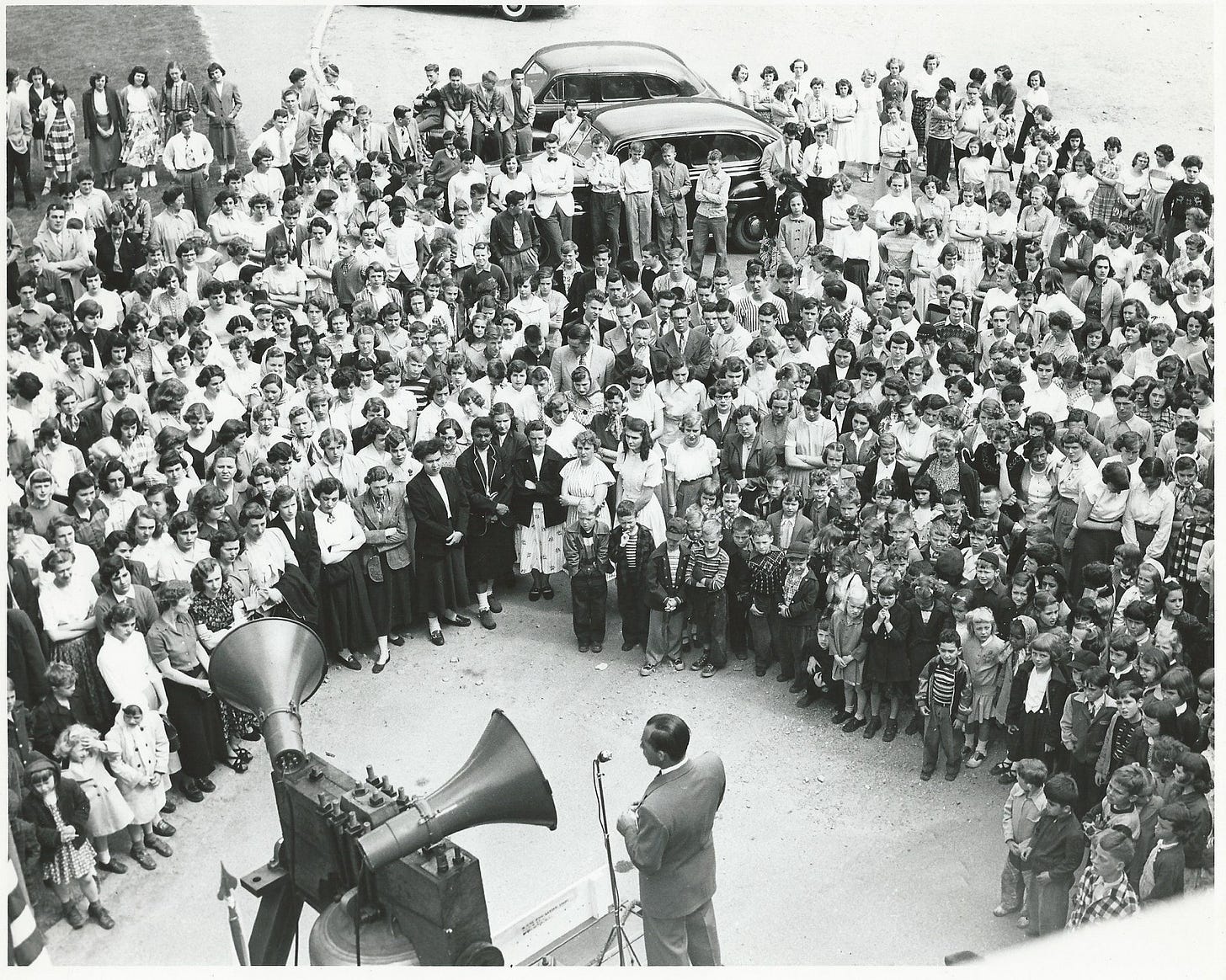
The 1950 Independence Bond Drive
In radio remarks from Chicago introducing the national Independence Savings Bond Drive in 1950, President Harry S. Truman presented his message fundraising for the government as a matter of sharing the responsibility of protecting freedom with other nations. These were not war bonds specifically, but Truman's speech suggested that prevention of further international conflicts was at the center of the need for a new bond drive.
"Today, it is not enough to preserve freedom and the spirit of cooperation only within our own borders. We must encourage those same ideals abroad. In the modern world, where one strong nation seeks to dominate all mankind, freedom will survive only if we cooperate with other freedom-minded countries in building common defenses against aggression. That is why we are keeping our military defenses strong, and why we are helping other countries develop their military, economic, and moral strength. That is why we find it necessary for the time being to spend a great deal of money on our Army, our Navy, and our Air Force, and on foreign aid programs. This is money invested in the cause of peace. Once again we are launched upon a united effort--a drive to 'save for our independence' through the purchase of United States Savings Bonds.
-Radio Remarks Opening the Savings Bond Drive: Harry S. Truman, May 15, 1950
United States Savings Bonds were first issued in 1935. They are treasury securities that are non-marketable bonds that protect the investor from loss. U.S. Bonds that were marketable securities were issued as far back as 1776 but their value was unstable, being dependent on changing markets. After WWI, Americans had lost money because their marketable U.S. Bonds ended up worth less than during the war when they bought them. U.S. Savings Bonds were introduced as a non-marketable form of bond. With these it was no longer possible to lose money from the investment.1
"When you buy a U.S. savings bond, you lend money to the U.S. government. In turn, the government agrees to pay that much money back later - plus additional money (interest)." -U.S. Treasury
Bond drives have functioned as marketing campaigns to get individuals to invest their personal money in the American government. Bond drives have been promoted by presidents and other political leaders such as the Chair of the Federal Reserve, as well as celebrities and have been promoted by radio, television, film, and live campaigning.
The 1950 Independence Savings Bond Drive had its own television special, which is listed in IMDb (Internet Movie Database) as an "hour-long bond drive by the U.S. Treasury Department hosted by Arthur Godfrey and featuring entertainment celebrities. The President of the United States, Harry S. Truman, makes a guest appearance." The special had several entertainment acts and celebrity appearances such as Sid Caesar and Perry Como.2
Liberty Bell Replicas
As a part of the independence theme of the 1950 savings bond drive, a replica of the Liberty Bell was sent to each state in the country, to be displayed in their State House for the public to visit. Before arriving at their destinations, the bells toured their states. Local events were held to draw people's attention to the savings bond drive, such as the event in the photograph of Andover students with the bell at their school. Trucks adorned in red, white, and blue were provided by the Ford Motor Company to transport the bells.3
"Proclaim Liberty Throughout All the Land Unto All the Inhabitants thereof"
- Inscription on the Liberty Bell
A bellmaster from Princeton University oversaw the "painstaking hand-manufacturing" of these replicas in Annecy-le-Vieux in Haute Savoie, France. In a ceremony for the Independence Savings Bond Drive bell replicas, at the site of the original Liberty Bell in Philadelphia, the bellmaster, Dr. Arthur Bigelow "told how old craftsmen, bell-makers all their lives like their fathers before them, had gone up into the Alps to bring down old timbers to make yokes for the bells."4
According to historian Gary B. Nash, in his book Liberty Bell, "exporting the Liberty Bell message became an important part of Washington's Cold War cultural strategy to stifle Communism." Not only were replicas of the bell sent to each state for the savings bond drive, one replica was sent to newly-established Israel in 1950, and another was sent to Japan in 1951 to sway opinion away from a Socialist form of government.5
On United Nations Day, October 24, 1950, an enormous 10-ton replica of the Liberty Bell toured the western world and was then presented in Berlin, Germany, in front of over 400,000 Berliners. The bell would be placed in Schöneberg‘s city hall and was given the name "World Freedom Bell."6
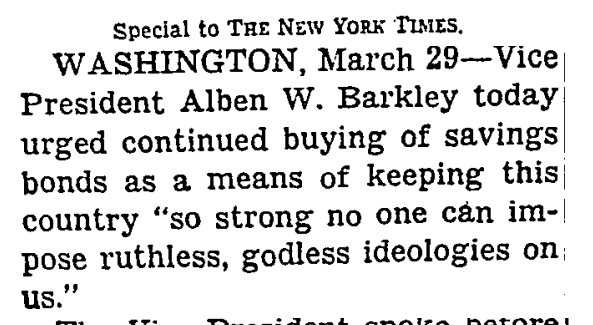
At the Massachusetts State House in Boston, the liberty bell replica has been out of public view for a number of years. After the 9/11 attacks on the World Trade Center and the Pentagon, security was intensified and more restrictive at government buildings all around the country. Increased security at the Massachusetts State House had the result of limiting visitor access to the outside part of the building where the bell resided.7
According to the deputy chief of staff for Massachusetts State Senator Senator Bruce Tarr, the bell is currently being restored in a non-public area, but within a year or so it will be moved to Doric Hall in the State House, where it will once again be in a place public visitors can see it.8
The Liberty Bell’s name and significance
Cold War era messaging about the Liberty Bell as a symbol of freedom and independence tended to omit its significant historical connection to abolitionists and suffragists. These groups raised the national profile of the bell by making their own replicas and conducting ceremonies to call attention to vast and continuing inequality.9
The name "Liberty Bell" itself was given not in its inception in 1751 but instead in 1835 by abolitionists when they adopted the bell as a symbol of striving toward equal treatment of all people of the United States.10
"Abolitionists, adopting the bell's inscription, used the words as a central focus of their cause–to abolish slavery. In fact, the first reference to the 'Liberty Bell' is attributed to the Anti-Slavery Record, published in 1835 for the American Anti-Slavery Society. A paragraph leading with the words 'The Liberty Bell(.)' written by R. G. Williams, says the bell's inscription was considered "a sort of prophecy," and yet, "the bell has not obeyed the inscription; and its peals have been a mockery, while one-sixth of ‘all inhabitants' are in abject slavery.'" - National Science Foundation
"Pennsylvania suffragists commissioned a replica of the Liberty Bell. Their "Justice Bell" traveled across Pennsylvania in 1915 to encourage support for women's voting rights legislation. It then sat chained in silence until the passage of the 19th Amendment in 1920." -National Park Service
While the Liberty Bell and its replicas were touring the world as a symbol of independence and freedom in 1950, there was still institutionalized inequality in the United States.11 It would be fifteen years until the Voting Rights Act was signed into law in the United States, protecting African Americans from intimidation from voting; four years until the Brown vs. Board of Education Supreme Court decision which ruled that "state-sanctioned segregation of public schools was a violation of the 14th amendment and was therefore unconstitutional";12 fourteen years until the passage of the Civil Rights Act, which "prohibited discrimination in public places, provided for the integration of schools and other public facilities, and made employment discrimination illegal";13 and thirteen years until the Equal Pay Act passed in Congress, "promising equitable wages for the same work, regardless of the race, color, religion, national origin or sex of the worker."14
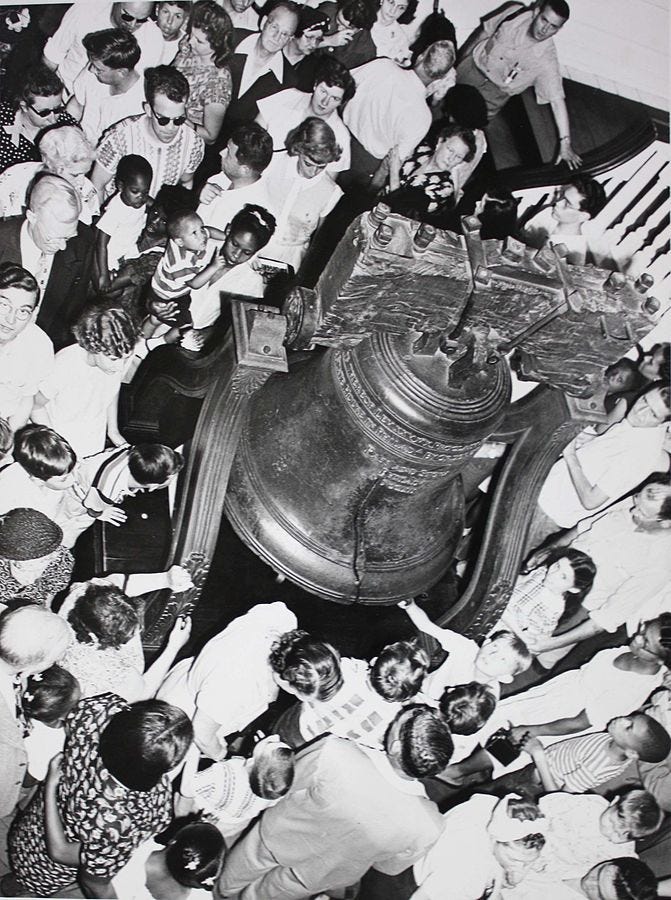
In the 2017 book The Cold War: A World History, Norwegian historian and Yale professor Odd Arne Westad, wrote about similar global blind spots that American foreign policy and messaging at this time contained, only in this case it was toward Third World countries that were decolonizing in the early days of the Cold War: "To Third World leaders the Cold War was an outgrowth of the colonial system. It was an attempt by Europeans to regulate and dominate the affairs of others, to tell them how to behave and what to do. Even though many in the newly independent states distrusted capitalism because it was the system their colonial masters had tried to impose on them, in most cases they were not ready to embrace Soviet-style communism as an alternative. It seemed far too regimented, too absolutist, or simply too European for postcolonial states."15
"The Liberty Bell's inscription is from the Bible (King James version): "Proclaim Liberty Throughout All the Land Unto All the Inhabitants thereof." This verse refers to the "Jubilee", or the instructions to the Israelites to return property and free slaves every 50 years. Speaker of the Pennsylvania Assembly Isaac Norris chose this inscription for the State House bell in 1751, possibly to commemorate the 50th anniversary of William Penn's 1701 Charter of Privileges which granted religious liberties and political self-government to the people of Pennsylvania. The inscription of liberty on the State House bell (now known as the Liberty Bell) went unnoticed during the Revolutionary War. After the war, abolitionists seeking to end slavery in America were inspired by the bell's message." - National Park Service
The Independence Savings Bond Drive in the early years of the Cold War was promoted by casting the world in terms of duality, as a struggle between two ideologies. Yet within the United States and in many places around the world, there were other perspectives and other concerns that were left out of the official narrative.
Who in our country was free to participate in our system? Who in other countries would be left behind if they were not a part of the dualistic struggle between two emerging global superpowers and their allies? These questions would continue to surface and grow harder to ignore as the Cold War progressed, as the struggle became one of extremes: the vertiginous threat of nuclear war and the delicate fine-tuning of soft power in the forms of cultural sway and economic enticements to draw nations toward one or the other side.
Image & Quotation Credits:
"Savings Bond Drive." Andover Center for History and Culture. Description: Black and white photograph; group of High School and Central School students who turned out to welcome the large Liberty Bell that visited the schools May 26th 1950. Albert Cole Jr. makes an address on the Independence Drive of US Savings Bonds. Accession #1993.096. Source: Donald Look. Andover Townsman June 1st 1950. https://andoverhistoryandculture.pastperfectonline.com/photo/BD7D8D55-62FD-11D9-AE5D-024842286480
"Radio Remarks Opening the Savings Bond Drive: Harry S. Truman." May 15, 1950. The American Presidency Project. UC Santa Barbara. Accessed: 1/7/23. https://www.presidency.ucsb.edu/documents/radio-remarks-opening-the-savings-bond-drive.
"The Beginning of the Savings Bonds Program." Treasury Direct. Accessed: 1/7/23. https://www.treasurydirect.gov/research-center/history-of-savings-bond/beginnings-of-savings-bond/.
" File:Crowd around the Liberty Bell, 1951 - cropped.jpg." Photograph by Abbie Rowe, photographer for the National Park Service. Wikipedia. Accessed: 1/13/23. https://en.wikipedia.org/wiki/File:Crowd_around_the_Liberty_Bell,_1951_-_cropped.jpg.
"Barkley Appeals for Bond Savings." New York Times. March 29, 1950. Accessed: 1/13/2023. https://www.nytimes.com/1950/03/30/archives/barkley-appeals-for-bond-savings-us-can-thus-be-kept-strong-he.html.
"Enduring Words, Liberty Bell Message Takes on Many Meanings." National Science Foundation. Accessed: 1/13/2023. https://www.nsf.gov/news/special_reports/liberty/01_history_02.jsp.
"The Liberty Bell." National Park Service. Accessed: 1/13/2023. https://www.nps.gov/inde/learn/historyculture/stories-libertybell.htm.
“Photograph of the original Liberty Bell.” Wikimedia Commons. Photo by: William Zhang, April 27, 2017. Accessed: 1/13/2023. https://commons.wikimedia.org/wiki/File:Liberty_Bell_2017a.jpg
"The Liberty Bell." National Park Service. Accessed: 1/13/2023. https://www.nps.gov/inde/learn/historyculture/stories-libertybell.htm.
References:
"The Beginning of the Savings Bonds Program." Treasury Direct. Accessed: 1/7/23. https://www.treasurydirect.gov/research-center/history-of-savings-bond/beginnings-of-savings-bond/.
"Treasury Bond Drive." National Broadcasting Company (NBC), television special. IMDb (Internet Movie Database). Accessed 1/7/23. https://www.imdb.com/title/tt12093270/?ref_=ttfc_fc_tt
Gary B. Nash. "The Liberty Bell." Yale University Press. New Haven & London. 2010. Accessed: 1/13/23. https://www.google.com/books/edition/_/UHpljq02J0MC?hl=en&gbpv=1&bsq=cold. Pages 155.
"Barkley Appeals for Bond Savings." New York Times. March 29, 1950. Accessed: 1/13/2023.
Gary B. Nash. "The Liberty Bell." Yale University Press. New Haven & London. 2010. Accessed: 1/13/23. https://www.google.com/books/edition/_/UHpljq02J0MC?hl=en&gbpv=1&bsq=cold. Pages 156.
"70 Years of Liberty Bell in Berlin - The history of the Berlin Freedom Bell." Bezirksamt Tempelhof-Schöneberg. Accessed 1/13/2023. https://www.berlin.de/ba-tempelhof-schoeneberg/ueber-den-bezirk/historisches/artikel.1122650.en.php.
Katie Lannan. "Liberty Bell Replica Might Get New Attention." Salem News. From State House News Service. Aug 27, 2018. Accessed: 1/13/23. https://www.salemnews.com/news/state_news/liberty-bell-replica-may-get-new-attention/article_669d174f-458c-500d-8f86-60a8eca8cd6b.html.
Office of State Senator Bruce E. Tarr. Phone interview with the senator's deputy chief of staff. 1/13/2023. https://malegislature.gov/Legislators/Profile/BET0.
"The Liberty Bell." National Park Service. Accessed: 1/13/2023. https://www.nps.gov/inde/learn/historyculture/stories-libertybell.htm.
"Enduring Words, Liberty Bell Message Takes on Many Meanings." National Science Foundation. Accessed: 1/13/2023. https://www.nsf.gov/news/special_reports/liberty/01_history_02.jsp.
"The Civil Rights Act of 1964: A Long Struggle for Freedom." Library of Congress. Accessed 1/13/2023. https://www.loc.gov/exhibits/civil-rights-act/legal-events-timeline.html.
"Brown v. Board of Education (1954)." National Archives. Accessed: 1/13/2023. https://www.archives.gov/milestone-documents/brown-v-board-of-education.
"Civil Rights Act (1964)." National Archives. Accessed: 1/13/2023. https://www.archives.gov/milestone-documents/civil-rights-act.
"Stepping Through History." U.S. News. Accessed 1/13/2023. https://www.usnews.com/news/the-report/articles/2017-01-20/timeline-the-womens-rights-movement-in-the-us.
Odd Arne Westad. "The Cold War: A World History." Basic Books. New York. 2017.


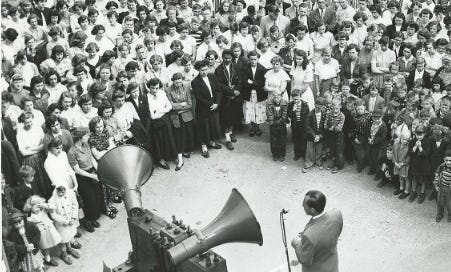


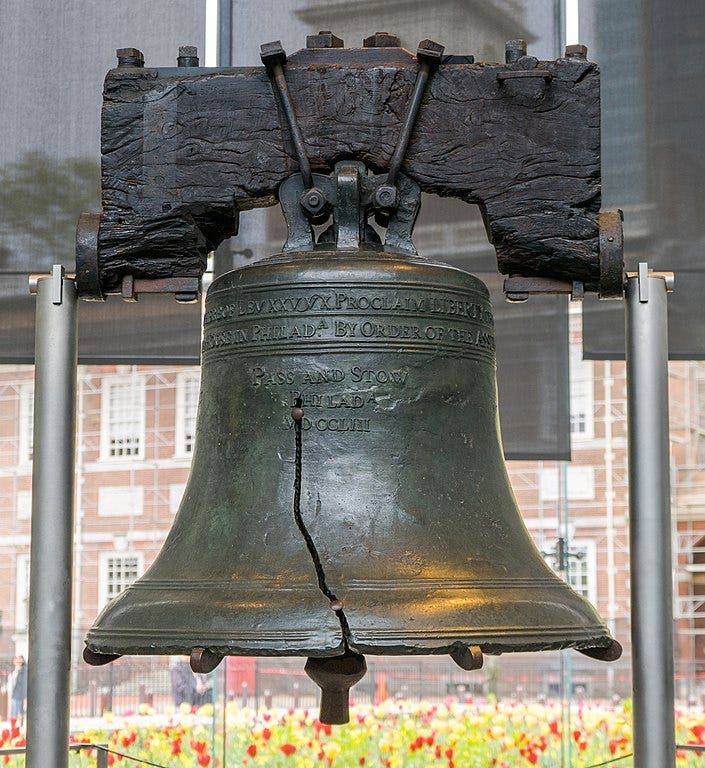
A very informative article. I recently finished a book on America during the Eisenhower presidency and it discussed the same themes. There was more than one ideology and system of values throughout the world. But, as far as the power brokers here in the US and the USSR were concerned: "might makes right"
Wonderful article Kathryn. I learn something new every day. I had no idea 50 bells were made and gifted out. I remember during the Bicentennial a Freedom Trian came to Andover and a "Liberty Bell" was on display.